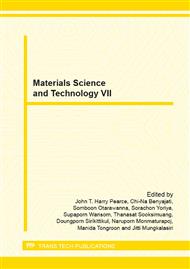p.122
p.129
p.134
p.143
p.148
p.153
p.158
p.163
p.173
Injection Moulding of Tungsten Carbide-Nickel Powders Prepared by Electroless Deposition
Abstract:
Tungsten carbide with nickel (WC-Ni) is generally used in applications in which high wear and corrosion resistance are required. In most cases, WC is mixed with Ni powder through a powder-processing route. In the present study, an electroless deposition technique was employed in order to prepare Ni coated WC particles prior to forming specimens by powder injection moulding method. The starting WC powders were subjected to surface activation followed by electroless Ni coating. The effects of a variety of processing parameters, including coating time and powder to electrolyte content ratio, were examined. The characteristics of the prepared powders were assessed by scanning electron microscopy and laser particle size analysis. It has been found that the fabrication of WC powder coated with Ni can be achieved through the electroless deposition technique. The amount of Ni introduced to the WC particles can be controlled by the powder to electrolyte content ratio and the deposition duration. The use of small particle loadings can ensure relatively large deposition and uniformity of the coatings. It is widely known that powder injection moulding (PIM) is an effective process for fabrication of small and complex shaped components of high performance materials. The PIM process includes 4 main steps: feedstock preparation, injection moulding, debinding and sintering. In this work, the WC-Ni powders were mixed with polyethylene glycol (PEG) and polymethyl methacrylate (PMMA) binder to form feedstock for injection moulding. The injection moulding process was carried out by a laboratory scaled, plunger-type machine. The mouldings were subjected to debinding and sintering. It was found that the PEG could be removed by water leaching. Specimens retained their shapes during and after leaching of the PEG. The remaining binder could be removed through pyrolysis. The mouldings were sintered under vacuum at 1400 °C for 1 hour. The sintered density achieved was at 88% of the theoretical value due to the low powder loading employed in the study.
Info:
Periodical:
Pages:
148-152
Citation:
Online since:
March 2013
Price:
Сopyright:
© 2013 Trans Tech Publications Ltd. All Rights Reserved
Share:
Citation:


